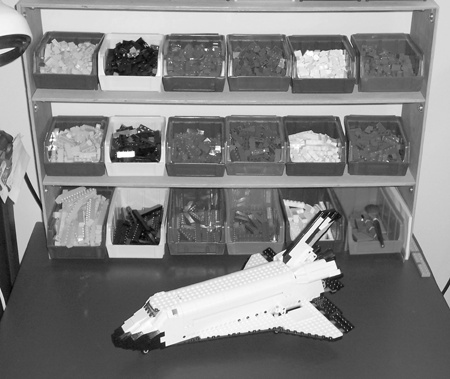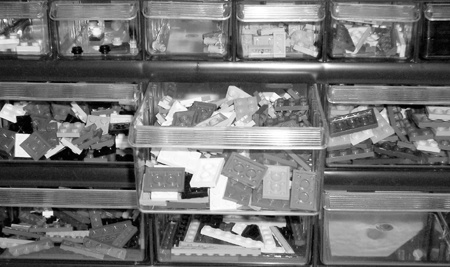At the end of all this sorting and storing, you still need to conquer the most important task of all: building something. If you’re like me, at some point in your life building with LEGO bricks was no more complicated than plopping yourself down on the floor and digging through your boxes of pieces. But now, having reached the stage where you’ve sorted and more efficiently stored your elements, you may also want to set up an area where you can build models and perhaps even leave bricks out between building sessions. As well, you have probably already realized that keeping most of your pieces in large storage containers, either on a shelf or in a closet somewhere, makes it more difficult to just sit down and create a model. That’s the main reason most builders eventually set up a specific area for their LEGO hobby.
A building area does not need to be an entire room; in fact, it doesn’t even need to be an entire table! You can make good use out of just about any amount of space that you can set aside for your hobby. Figure 12-9 shows a building table that’s not even three feet wide, but it serves the purpose nonetheless.
Figure 12-9. Your LEGO building area doesn’t need to be fancy or large. It only needs to be a place where you can work effectively.
First, and most obviously, you need to decide how much space you’ve got to work with. Maybe you’re lucky enough to have a small spare bedroom available, or perhaps a corner of a basement that you can call your own. On the other hand, your LEGO building area might be just an area under a window or along one wall of a spare room. Or, you may have to share a large table with someone else’s hobby. No matter what space you find yourself dealing with, the basic ideas behind setting up your workshop are the same.
Decide which LEGO elements are most important to the style of building you do. Maybe you want lots of gray and brown elements for building castles. Or perhaps you want most of your plates handy because you like to work on sculpture or mosaics. Or perhaps you want several common colors and sizes of basic elements available because you can never decide what you’re going to build next.
Decide how much of your work area you want to set aside for keeping the elements from step 1 close at hand. Remember, it’s great to be surrounded by thousands of pieces of LEGO, but if you’re only left with one or two square feet of building space, then you’re not going to enjoy yourself very much.
Find storage bins or containers that are suitable based on the decisions made in both step 1 and step 2. These may be small, open-front sorting bins (as in Figure 12-9), or they may storage units that feature lots of small drawers (as in Figure 12-10) in which you can keep your most needed bricks.
Figure 12-10. Sets of small plastic drawers offer great organization solutions that allow you to see your bricks from the front.
To make your building area most effective, you should also give at least some consideration to the following:
- Lighting
If at all possible, try to illuminate your building table/area with lights that give off simulated natural daylight. These are a bit more expensive than normal light bulbs, but they offer you a better view of all your colorful LEGO pieces.
- Chair
Assuming you are going to sit at your table (and you may not), you will want to get the most suitable seat you can find. This may be a swiveling, office-type chair or nothing more than a simple stool with a backrest. The point is that you are comfortable during your building sessions.
- Atmosphere
This can be anything from the overall lighting of the room (sunlight vs. artificial light) to whatever other things you bring into it (for example, is this room strictly for LEGO or does it share space with your other hobbies?). As with the chair, this is all about making yourself comfortable. If you set up a huge LEGO table in the darkest corner of a damp, musty basement, you may not be as inspired as you would be if you picked a smaller space in an upstairs spare bedroom that has a good-sized window. In addition, think about having the ability to play some music when you build; that can also create an environment that’s more suitable for your creative endeavors.
As with the decisions about how to sort and what to use for storage, the decisions about setting up your work area will be a mix of different answers. Not every solution noted here will work for you, but parts of one or more may work very well. Adapt your work area to your style of building, and your collection and you can’t go wrong.


